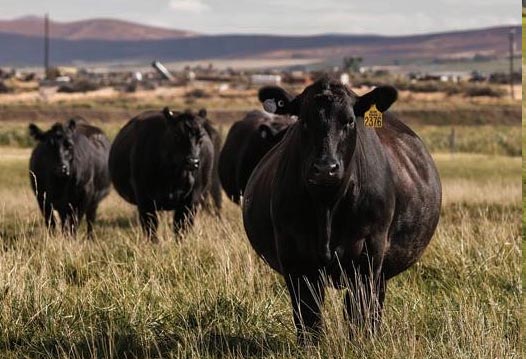by Lilly Platts
The industry’s push for larger carcass weights continues to put pressure on commercial producers who must also maintain a productive, profitable cow herd. Dr. Jamie Courter, Assistant Professor and State Beef Extension Specialist at the University of Missouri, explored this dichotomy during Fall Focus 2025.
Optimizing efficiency and productivity are central goals for all cow-calf producers. The end product and the demands of the packer are also a consideration, and often go against what is best for long-term cow-calf profitability. Bigger cows can produce bigger calves, but at what cost? Courter shared that the push for bigger carcass weights will continue in the future, and because of this, focusing on cow herd efficiency and profitability is more important than ever. “Whether we’re talking about the end product, or selling a weaned calf, your motivation should still be the cow,” Courter shared.
Mature cow size has been steadily increasing over time, which is evident in data across breed associations. Courter evaluated Angus, Red Angus, and Simmental trends, and saw a uniform trend throughout. “Regardless of breed, we are increasing cow size,” she said.
The cow-calf phase of the production cycle accounts for 74% of the overall input required to produce one pound of carcass weight, and the bigger the cow, the higher this number is. “A 30% larger cow will consume 22–28% more dry forage matter,” Courter shared. “Mature cow weight matters.”
Courter encourages producers to think about their cow herd as a whole unit, as opposed to individual animals. Heavier calves may bring more on sale day, but if the female that raised that calf required more input, those extra dollars may cancel out. “Yes, heavier calves make more money, but if we think about fixed resources, smaller cow size and more moderate weaning weights aren’t always a bad thing,” she said. Crossbreeding
Many beef cattle traits are optimized somewhere in the middle, like docility, and Courter believes the same is true for cow size. An 1,100- to 1,200-pound cow usually strikes the right balance between input and productivity, and Courter encourages producers to look at their output as pounds weaned per acre, as opposed to individual cow performance. “The key is to avoid cows that are over 1,400 pounds, and that are consuming more nutrients than they are providing you in profit,” she said. “The data shows that mature cow size is an intermediate-optimum trait.”
Birth weight is as frequently discussed as mature cow size, and is another important factor in optimizing productivity. There are several EPD associated with birth, including calving ease direct, calving ease maternal, and birth weight. Calving ease direct predicts the probability of a first-calf heifer experiencing dystocia; calving ease maternal predicts the probability of first-calf daughters experiencing dystocia; and birth weight predicts the calf’s weight compared to the breed average.

Courter shared that producers often put emphasis on the wrong trait. “Time and time again, producers think that birth weight is equivalent to calving ease, especially on the commercial side,” she explained.
Using correlations, Courter explained that birth weight and calving ease are genetically related, but not the same trait. Conversely, the correlation between calving ease direct and the percentage of unassisted births is high. This means that producers who select primarily for birth weight may only be starting off with lighter, more issue-prone calves, and not actually solving dystocia problems.
“When we select for low birth weight, we are not solving the problem,” Courter shared. “Selection for birth weight does not ensure calving ease. It just creates light calves.”
Data shows that calves that start out lighter will also be lighter at weaning and yearling. Commercial producers often use birth weight over other calving EPD when selecting bulls, which may lead to long-term financial loss. If calving ease direct predicts that a first-calf heifer can have a 60-pound calf unassisted, then putting emphasis on birth weight and pushing that weight down to 50 pounds is only taking pounds away long-term. “We need to be having these tough conversations with our commercial buyers,” Courter shared.
Crossbreeding is one of the most reliable methods for increasing productivity while maintaining input costs, and Courter emphasized this. “We know that crossbred cows raising crossbred calves wean over 23% more weaning weight per cow exposed,” Courter said. “Crossbreeding and mating systems will increase the resources we have while keeping cow size moderate.”

Above: Dr. Jamie Courter shared about the implications of cow size, and potential strategies for balancing productivity with cost.
Below: Cow size has a significant impact on input and overall production cost.


Courter encouraged producers to consider crossbreeding systems, as well as maternal and terminal herds.
Increasing carcass weights while keeping cow size moderate is difficult, and while genetics and technology have produced bulls and cows that “do it all,” genetic potential can only go so far. Pushing the cow herd to meet end-product demands could have negative long-term effects. “If we want to avoid doing that to our cow herd, we need to start thinking about the story differently,” Courter explained. “We need to start thinking about creating maternal cows that will be the factory, while also creating terminal animals that are all pounds weaned,” Courter shared.
Specific crossbreeding systems have been considered labor- and resource-intensive in the past, but Courter countered this belief. Other industries, like dairy, have been successfully using sexed semen and technology to create maternal and terminal crosses. “With the advent of AI, sexed semen, and genomic testing, we are past that. We are past the argument of it being labor-, cost-, and resource-intensive,” she said.
Courter concluded that through crossbreeding and technology, producers can meet the demands of the industry while also maintaining profitability in the cow herd. “My challenge to you is this. How can we adopt technology to meet what the market is telling us, and at the same time, not detrimentally impact our cow herd?”




